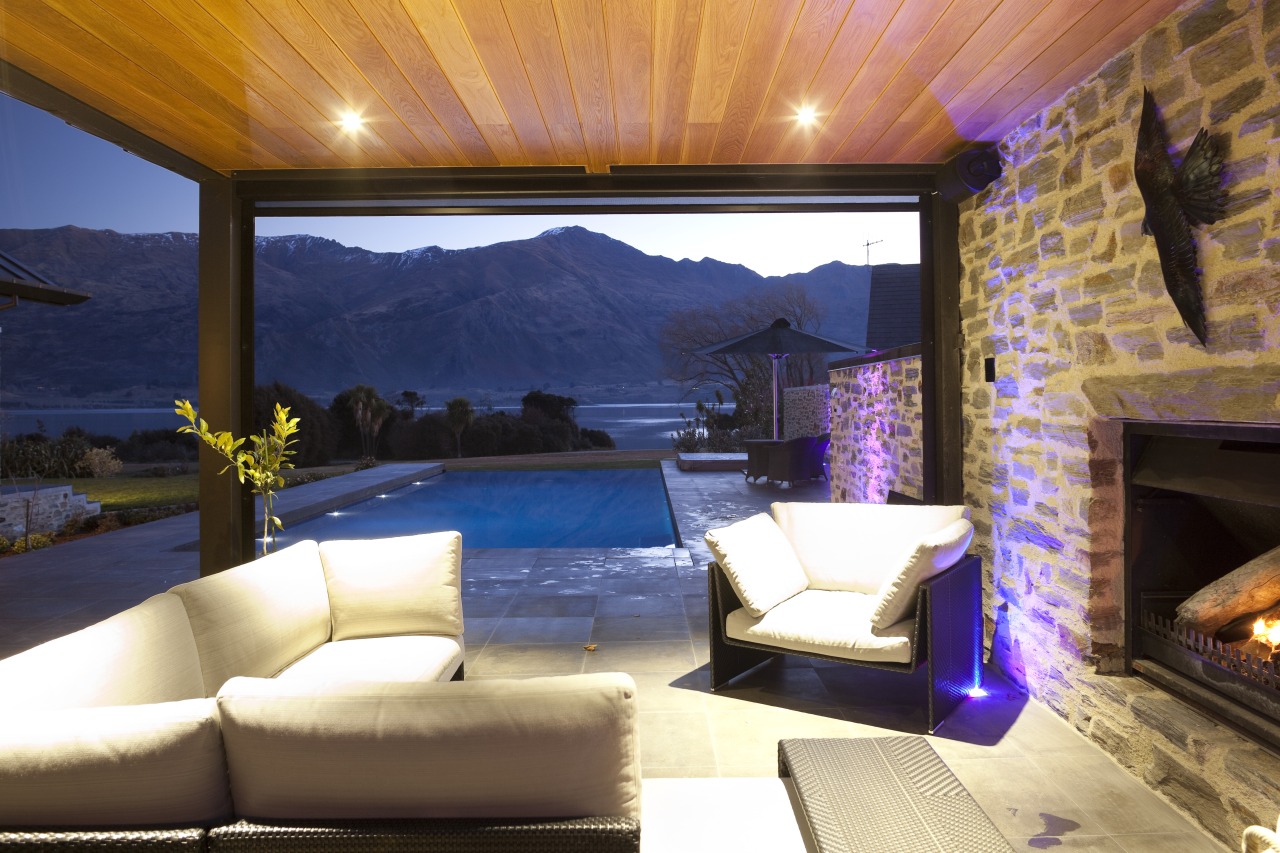New Wanaka house by Mason and Wales
Wanaka house reflects alpine setting
In Central Otago, it’s all about the big picture – the wider landscape that impacts on every aspect of a house design.
Since the arrival of the first settlers, the rugged mountain and picturesque lake scenery have helped to determine the architectural vernacular of gabled roof lines and schist stone walls.
This Wanaka house, which was designed by architects Regan Johnston and Francis Whitaker of Mason and Wales Architects, puts a contemporary spin on this tradition. The house comprises a cluster of linked pavilions, with gabled alpine roofs.
“The roof of the central living pavilion is raised higher than the rest of the house,“ says Johnston. “With clerestory windows along one side and fully glazed gabled ends, the roof appears to float above the house, but at the same time, it is visually anchored by the solid schist stone walls, chimneys, and stone floor.”
Johnston says the materials and construction detailing reflect a philosophy adopted by the firm.
“We set out to deliver a sophisticated, contemporary architecture that is both warm and tactile.”
Natural materials feature strongly, and include the bagged schist walls, oak-lined ceilings and a granite mantelpiece. Schist also forms the key landscaping material, reinforcing the easy indoor-outdoor connection.
“Houses in Central Otago have an opportunity to connect with the wider landscape beyond,” says Johnston. “As well as providing sightlines that maximise the spectacular views, we opened up the house to the outdoors. Large pivoting glass doors in the main living area were the best way to provide an uninterrupted outlook. Unlike bifolds or stacking doors, they don’t take up extra space when open.”
The living pavilion – and a separate guest wing – open out to loggia-style outdoor living areas that provide plenty of shelter from the heat of the sun and breezes in summer. These loggias face west and overlook the pool and lake.
“At other times, the sun is welcomed,” says Johnston. “The glazed ends of the gables allow sunlight into the main living area first thing in the morning and late in the evening. And of course, the view is maximised by the large expanse of glazing.”
Tradition gives way to modernity in the kitchen, at one end of the living room. Interior designer Bruce Crowley of Crowley Design, who was involved in the project right from the outset, says the owners opted for the sleek, contemporary lines of a high-gloss, black-lacquered Arclinea Italian kitchen. Wherever possible appliances are integrated into the cabinets.
“The cabinets reflect the light and the mountain views that can be seen right through the spine of the house,” says Crowley. “The gloss black is teamed with a stainless steel island and benchtops, although we added a black oak edging to the bar top to give it a textural look and to make it less industrial. The bar stools are black leather – it was important that they look like an integral part of the kitchen and not an afterthought.”
Crowley says furniture in the main pavilion was chosen to balance the large scale of the living room.
“This was a big space to fill – the ceiling is 6.5m high in the centre of the room – but it was essential to give it an intimate quality,” Crowley says.
Furniture is grouped around a gas fire, and includes custom-made coffee tables with oak tops and handmade iron legs. Carpet was inlaid in the marble floor to help soften the space visually, without compromising the clean-lined, contemporary feel.
“There is a lot of layering in the interior, with contrasting textures adding plenty of visual interest – just like the contrast provided by the building materials,” says the designer. “In the sunroom, for example, the polished marble floor is balanced by the textural wicker seating and leather dining chairs.”
To maintain a light, yet warm look, the walls are painted in a soft neutral that complements the marble floor.
“This room is very long and relatively narrow, with a lot of circulation areas leading off the space,” says Crowley. “It could have resembled a bowling alley, but having two functions – the dining area and casual seating – helps to give the room a strong identity.”
ESD initiatives ensure the sunroom, like the rest of the house, is warm in winter. All the windows and doors are double glazed, argon filled, and incorporate e-glass for good insulation.
Other key ESD features include solar water heating. Panels on the roof provide hot water for the house and the pool. Johnston says the panels alone can keep the pool at a temperature of up to 32°C for six months of the year.
“The water heating and insulation systems were developed in conjunction with AirComm Consultants to make the house as energy efficient as possible.”
Credit list
Architect
Mechanical engineer
Landscape designer
Spa
Kitchen manufacturer
Roofing
Flooring
Blinds
Fireplace
Televisions
Benchtops
Ventilation
Interior designer
Builder
Pool construction
Kitchen designer
Cladding
Skylights
Tiling
Blinds
Audiovisual equipment and home automation
Kitchen cabinets
Oven, cooktop and dishwasher
Story by: Colleen Hawkes
Photography by: Jamie Cobeldick
Home kitchen bathroom commercial design
Reflection and repose
9 tile shapes and finishes that think outside the square
Curves upon curves
















